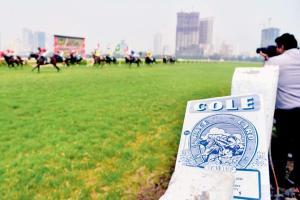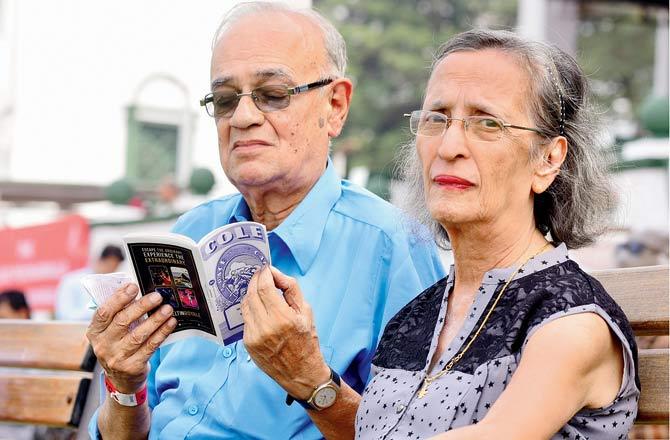As Mumbai's definitive race-day guide booklet turns a 100 years old this month, the family behind Cole shares their fact-checking tips.

Pics/Ashish Raje
It's December when we meet them. The Adwalias are only a month away from making history. Set amid a cluster of electrical shops on Lamington Road, Turf Printing Works holds its ground. There is not a single proprietor in the neighbourhood who is alien to the making of this enterprise. And, when we meet the owners behind this printing house, Vijay Adwalia and son Hemin say it's no surprise. Cole, the racing booklet they publish, has survived the sands of time, galloping towards its centenary. "For the last 100 years, Cole has been the bible for racegoers in Mumbai. And will continue to be," says Vijay, 68.
ADVERTISEMENT
In 1920, when racing action began at the Mahalaxmi Racecourse, the Cole Race Card was born. On the grounds, competition was fierce and very soon, the racetrack was ritualised as entertainment for the elite. One would believe that wearing a hat to the races was a tradition highly upheld, but that wasn't the case. For those who sought quick fortunes at the Royal Western India Turf Club, carrying the most thorough and informative guide topped the priority list.
 Vijay Adwalia, 68, has printed the Cole racing book from the Turf Printing Works, Lamington Road, after he took charge of the business in 1992
Vijay Adwalia, 68, has printed the Cole racing book from the Turf Printing Works, Lamington Road, after he took charge of the business in 1992
Started by the late Ranchhoddas Manchharam, Cole was initially printed at Marine Lines. In 1927, Ranchhoddas's brothers-in-law Hargovandas joined the business with Vallabhdas Adwalia. A few years later, it was rechristened Turf Printing Works and moved to the current address. In 1955, Vallabhdas took complete control of the business, which was eventually, in 1992, handed down to his son, Vijay. "I was only 21 when I started going to the races. When the torch was passed to me, I was not just printing Cole, but multiple publications. We would print balance sheets for banks, military booklets and even Bharatiya Vidya Bhavan titles. We had 120 workers back then, each assigned a job from cutting, binding, folding to printing," he says.
Cole remained a priority. Vijay, with a correspondent of Cole in tow, would attend the races with binoculars. "Back then, there was no video recording. So, you had only one chance to watch a race. We used the lens to closely observe every little detail; timings, bend positions, etc. And the correspondent would subsequently write everything down on a piece of paper." All this data was printed in the book within one day, in time for the next race allowing punters to assess ways to win, by betting on the best horse. "Things are different now. You can watch all the races over and over online," his 42-year-old son Hemin says, adding, "Back in the day, the club's commentator would repeat all the details after the race concluded. If you had missed out on any point, this was the time to make up for it." But Vijay says that was not always reliable. "We ensured that we printed only what we saw during the race and not what the commentator said after."
 The cover of Cole has remained the same since 1920, except in 1961 when Queen Elizabeth II visited India and the racecourse
The cover of Cole has remained the same since 1920, except in 1961 when Queen Elizabeth II visited India and the racecourse
The father-son banter continues. "The cover of Cole has remained the same since 1920. The only time it was changed was in 1961, when Queen Elizabeth II visited India, and the Mahalaxmi Racecourse. We had a special issue printed in her honour," Vijay adds. It was around then that Cole's popularity rose. "Some years later, the jackpot amount a punter won was close to R23 lakh. That year, Mumbai saw the highest attendance [until then]. More than 39,000 people turned up at the grounds. Racing was at an all time high. Just then, somebody hit a jackpot of R46 lakh and the then Indian government announced betting tax. After that, the number of punters went down."
After Vijay formally took charge of Cole, he invested in computers. "Around 1995, he [Vijay] sold 6 to 7 tonne lead [from old machines] in scrap. Technology was taking over and we had to embrace it," says Hemin, who joined the business in 2000. The number of workers at Turf Printing has now dropped to 30. "Nothing is done manually anymore, we rely on modern technology for printing," he adds.
Even the number of copies sold has declined. "In 1992, I sold close to 7,000 books per race. It's down to about 4,000 to 5,000 now. There was a time when we would run out of books for the excited buyers standing at our door..." It's the same with advertising revenue. What was once called the king of sports has barely any takers today.
 Hasmukh bhai Chawda takes the local from Kandivli to Mahalaxmi to attend the races and although admits to losing a fair bit over the years, calls Cole Mumbai’s most reliable racing book
Hasmukh bhai Chawda takes the local from Kandivli to Mahalaxmi to attend the races and although admits to losing a fair bit over the years, calls Cole Mumbai’s most reliable racing book
On asked why the current generation stays away from the races, he explains, "Although they have other sources of entertainment like going to the malls or watching movies or frequenting restaurants, we have gained quite some support from the modern generation as well. But the youngsters enjoy these modern amusements more than this old-fashioned system of entertainment."
While there are some who call betting a sin, Vijay argues that the history of gambling in India dates back to the Ramayana and Mahabharata. "If you go into India's villages, even today you'll see young boys gambling with pebbles. It is entertainment and should be considered such. GST has only further crippled the racing industry in India."

Hemin speaks of America, Hong Kong, South Africa and United Kingdom organising races, and how the Melbourne Cup Carnival in Australia, held every November, is declared a national holiday.

Amidst the change, what's remained constant are the colour, font, number of pages and the notes and comments section, where the horse that performed better than the rest, finds mention.
 The races are frequented largely by senior citizens. The Adwalias say malls, movies and restaurants ensure the young consider racing fuddy-duddy entertainment. Pics/ Shadab Khan
The races are frequented largely by senior citizens. The Adwalias say malls, movies and restaurants ensure the young consider racing fuddy-duddy entertainment. Pics/ Shadab Khan
There is another constant—loyal readers. Hasmukh Chawda, a 73-year-old punter, has been attending the races since 1989, always carrying a copy of Cole. The chemical trader, who retired in 2008, continues to attend every race at Mahalaxmi despite moving residence from Churchgate to Kandivli. "I don't like to get stuck in traffic, so I take the train. Once I attended all the eight outstation derbys held over three months. It was like doing a temple tour during a yatra," he laughs. In March, Chawda suffered a stroke, but when this writer visited the turf last fortnight, he was cheering for his favourite team. "I have barely won, mostly lost. But Cole has come handy for many punters in the last 100 years. It is the most reliable racebook in the city," he adds.
 In 1995, the Adwalias sold 7 tonne of lead from old machines in scrap
In 1995, the Adwalias sold 7 tonne of lead from old machines in scrap
So, is there hope that the fifth generation of the Adwalias will carry on the business? "If the number of races go up, why not?" Hemin says. Talking about their plans to mark Cole's 100th birthday, Vijay shares, "We will be sponsoring a special race in February. It will be called the Centenary Cole Trophy. And then, we will come back at Turf Printing Works to celebrate with our staff."
 Vijay's son Hemin joined the business in 2000
Vijay's son Hemin joined the business in 2000
 Subscribe today by clicking the link and stay updated with the latest news!" Click here!
Subscribe today by clicking the link and stay updated with the latest news!" Click here!






